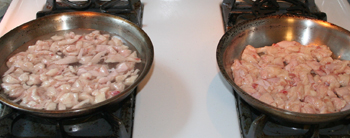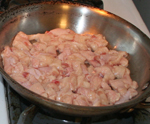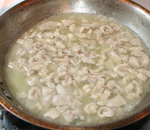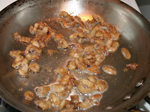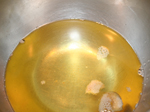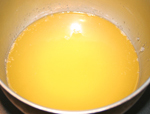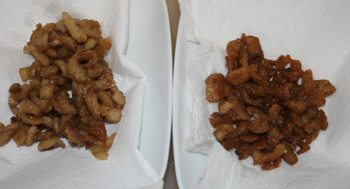|
How to Make Duck Fat |
ABOUT DUCK FAT
Duck fat contains 35.7% saturates, 50.5% monounsaturates (high in linoleic acid) and 13.7% polyunsaturated fats.(which contains Omega-6 and Omega-3 essential oils). This compares to olive oil which is: 75% monounsaturated fat (mostly oleic acid) 13% saturated fat and 10% Omega-6 linoleic acid and 2% Omega-3 linoleic acid. The main difference between chicken, turkey and duck is that duck contains more linoleic acid, which chicken and turkey contain a higher amount of polyunsaturated fats --- Read more about Health Benefits of Duck Fat
A comparison of the two methods for How to Make Duck Fat
| METHOD I: BOILING THE FAT IN WATER | METHOD II: RENDERING THE FAT WITHOUT WATER | |
| Remove the fat from the duck. | Remove the fat from the duck. | |
| Chop the fat into very small pieces | Chop the fat into very small pieces | |
| Add the fat to a frying pan and spread out to cover | Add the fat to a frying pan and spread out to cover | |
| Cover the fat with water | Cook on a low flame allowing the fat to melt | |
| Cook on a medium flame allowing the fat to render into the water | As fat renders spoon off into a bowl | |
| Continue to cook until the water has evaporated and only a slight simmer is visible | Continue cooking till most of the fat has been rendered | |
| Filter off the duck fat reserving the remain fat for cracklings | Filter off the duck fat reserving the remain fat for cracklings | |
| Store overnight in the refrigerator | Store overnight in the refrigerator | |
COMPARISON OF THE TWO METHODS
The two methods were compared: 300 grams of diced fat were added to two separate frying pans.
|
|
|||||||||||||||||||
|
|
|||||||||||||||||||
|
|
|||||||||||||||||||
|
||||||||||||||||||||
|
||||||||||||||||||||
To see if the cloudiness during preparation and the softer texture of the fat was due to water retention we calculated the density for both fats preparations. |
||||||||||||||||||||
DENSITY METHOD I = 0.906 G/CM3 This value is consistent with most fats and oils. |
DENSITY METHOD II = 0.946 G/CM3 This value indicates the presence of water. Note: the density of butter can vary between 0.911 and 0.95 depending on amount of water. |
|||||||||||||||||||
Pros and Cons for each method -- How to make Duck Fat--
Method I provides for a clearer more pure form of duck fat. Method II retains water which can decrease shelf-life. In addition Method II requires constant watching during the rendering process. However for small amounts of duck fat Method II is preferred.
Note: Duck fat which may contains water should not be added to a very hot pan since the fat may splatter. Add to a low heat pot and allow the sizzle to die down first.
See also a YouTube Video on rendering fat using Method II---- You Tube video on how to render fat
Science of Cooking
See also:
- How can dried Shitake mushrooms be more flavorful than fresh mushrooms
- Adding Flavor by using Umami
- Artificial Sweeteners
- Science of Culinary Foams
- Food Thickening Agents
- What is Sous Vide Cooking
- What are Polysaccharides?
- Xanthan Gum
- Guar Gum vs. Locust Bean Gum
- Agar Molecular Properties in Cooking
- Pectin
- Science of Hydrocolloids in Cooking
Health Risks in Cooking
- What are Trans Fats?
- What is lactose intolerance?
- What is the difference between LDL and HDL?
- What are the different types of Omega-3 fatty acids?
- What is the difference between nitrates and nitrites?
- What is the difference between saturated and unsaturated fats?
- Why is Carbon Monoxide used in meat and fish?
- All about gluten sensitivity and issues with lectins
